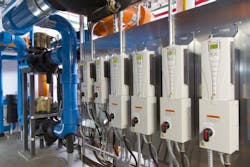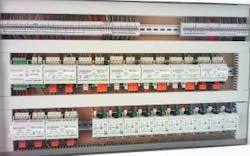Project Profiles: BACnet, LonWorks Improve Building Control, Efficiency
The previously vacant Red Deer Bowladrome, Alberta, Canada, was recently transformed into the offices of Berry Architecture + Associates. The building is now a sustainable, LEED Silver targeted facility as a result of the implementation of a BACnet system as provided by BACnet International Gold Member Reliable Controls of Victoria, British Columbia. The controls installation was engineered by Independent Control Services, also based in Red Deer.
The networked hardware in the project included BACnet/IP communication and control of a third-party air handling unit, BACnet/MSTP communication of a third party humidifier, and BACnet/MSTP communication of all MACH-Air controllers to the MACH-ProWebSys. Features of the improved facility include lighting, heating, and ventilation zones; open spaces with natural light; motion sensors for energy reduction; and a green roof featuring a patio, local plants, butterfly gardens, bee boxes, hummingbird nests, herb/vegetable gardens, solar panels, and water collection.
“BACnet International exists to promote the successful implementation of the BACnet protocol,” says Andy McMillan, President and Managing Director of BACnet International. “The Berry Architecture + Associates offices are a prime example of how BACnet can be utilized to transform and improve an existing facility.”
BACnet International is an industry association that facilitates the successful use of the BACnet protocol in building automation and control systems through interoperability testing, educational programs and promotional activities. The organization oversees operation of its BACnet Testing Labs (BTL) and maintains a global listing of tested products (bacnetinternational.net/btl/). The BACnet standard was developed by the American Society of Heating, Refrigerating and Air-Conditioning Engineers (ASHRAE) and has been made publicly available so that manufacturers can create interoperable systems of products.
ABB Puts BACnet to Work for HQ Facility
Variable-frequency drive manufacturer ABB recently undertook a facelift of it’s 147,000-sq. ft. manufacturing facility in New Berlin, WI. Frankly, with continued growth in sales for their variable frequency drive (VFD), along with the addition of new products — such as medium voltage drives, electric vehicle charging stations, power electronics, and controls products— ABB just outgrew the existing building.
The existing design of the facility’s HVAC system dated back over 30 years. There was no central plant or building automation system (BAS) and most control was independent. Monitoring, maintenance, and troubleshooting were all done the old fashioned way. In order to deal with this and the many other challenges that come with an aging system, ABB sought to design a highly intelligent and flexible building. The final design included a BACnet communications environment that plays a critical role in both monitoring and control of the new system with nearly every device in the HVAC system.
Serial communications also played a key role in either the monitoring and/or control of other advanced HVAC systems. Some application examples include:
• The HVAC system is designed such that the chiller will make ice (thermal storage) during off-peak summer hours to take advantage of low utility rates.
• The automation system optimizes the chiller by monitoring the building’s energy meter, trending performance, outside air temperature, water temperature, ice levels, etc.
• The warm chiller condenser water can be used for variable air volume (VAV) reheat, instead of simply going out to the cooling tower. This nearly eliminates the need for boilers in the summer.
• The two boilers talk to each other via serial communications, determining the most efficient operating point.
• The four fan FANWALL unit has a single VFD per fan motor. Via serial communications, the unit’s PLC starts and stops the individual fans as required, to operate at the most efficient operating point.
• Demand-controlled ventilation that monitors the buildings indoor air quality (CO2 level) and appropriately controls the amount of outside air brought into the building.
• The chilled, condenser, and hot water systems are all designed as N+1 systems. Two VFDs and two pumps are used, instead of a single VFD and pump. If a VFD, motor, or pump were ever to fail, the BAS would seamlessly switch over to the back-up system.
Since 2007, LonMark International has recognized products, companies, projects and individuals that have demonstrated superior levels of expertise with open control networking technology based upon the ISO/IEC 14908 standards. Here are two winners from 2013. Winning projects from 2014 will be announced during the 2015 AHR Expo in Chicago, Jan. 26-28, 2015. lonmark.org
LonMark Multi-Vendor Project of the Year (Large Campus Integration Category)
One of the most ambitious residential projects in Spain is the Altos del Hipódromo neighborhood in which all 48 homes and private social club are automated, monitored, and centrally and remotely controlled. ISDE Company of Madrid, Spain —
a LonWorks–focused pioneer of home and building automation and street lighting — took the challenge of integrating hundreds of devices for the upscale neighborhood while keeping the cost at a minimum.
The integration and automation of the Altos del Hipódromo neighborhood brings up to 20% savings in energy consumption (lighting dimming, motion sensors, etc.) and up to 25% in reduced maintenance cost, thanks to the Smart Servers, which makes remote management possible.
More than 2,000 controllers are installed throughout the property. Inside each home, residents can intuitively manage their environments (i.e., heated floors, HVAC, access control) via a touchscreen keypad and from a touchscreen table.
LonMarkMulti-Vendor Project of the Year (Small, Repeatable Solution Category)
As the biggest “Internet of Things” intelligent street lighting solution” provider, Guangdong Rongwen retrofitted the street lighting system of the district of Guancheng in Dongguan, China. This project is part of a larger initiative that’s creating an Read about more winners at Lonmark International's "Best of 2013" Awards.




